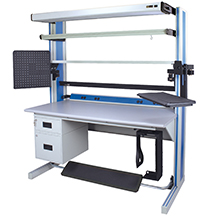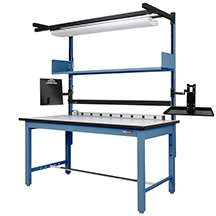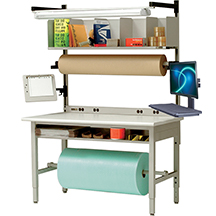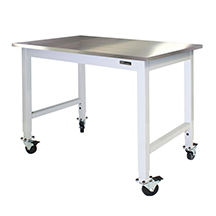Buying a Workstation: What Height Adjustment Option to Choose?
By Joy M. Ebben, Ph.D, CPE
Human Factors and Ergonomic Specialist, IAC, a Division of Treston, Goodyear, Arizona
When the time comes to choose a workstation, an important characteristic to watch for is how much flexibility you need in making height adjustments. Incorrect working height is often responsible for the risk factors—extreme postures and motions. It’s important to remember that the key term here is working height—almost always different from the work surface height because the height of the task depends on both task performance and the object of the task.
The height of the work surface is relative to the height of the object being worked on and the task being performed.
If the person is soldering on top of a subassembly that is six inches high, the working height is the worksurface height plus 6 inches plus any additional height required for the use of the soldering tool. Thus the height of the work surface is relative to the height of the object being work on and the task being performed. The type and range of height adjustments have a significant impact on the cost of the workstation. This is why it’s so important to be sure of your true requirements so you spend your workstation dollars wisely. There are several different recommendations for appropriate working height—all of them defined relative to the user’s elbow height. Typical worksurface height recommendations are:
- Six inches above elbow height for “fine detail” work such as proofing documents or inspecting small parts.
- Four inches above elbow height for precision work such as mechanical assembly.
- Same height as elbow for writing or light assembly.
- Four inches below elbow height for work requiring physical exertion, such as packaging.
Adjusting To Elbow Height
Some of the ways to manipulate the relative height of the workpiece in relation to the workstation user’s elbow are to:
- Adjust the chair height.
- Adjust the worksurface height, e.g., cut off the legs, put blocks under the legs, use the height adjustment mechanism provided by the workbench manufacturer.
- Adjust the height of the equipment being used by making adjustments on the equipment itself or by providing accessories—platforms and mechanical lifts to hold it.
- Adjust the height of the workpiece by using a fixture.
All of these approaches call for an appropriate height adjustment of the other components of the workstation components, e.g. the chair, footrest or arm support.
There are five catagories of surface-height adjustable options provided by most workbench manufacturers, and each of them impacts the cost. They are: fixed; fixed, with leg or pedestal extenders; manual adjustment; crank adjustment; electric motor-driven adjustment.
Does the workstation fit the tallest user and does it have a properly designed chair and footrest with sufficient adjustment range?
Fixed.
No adjustment is possible. This is acceptable when:
- The height is appropriate to fit the tallest user and a properly designed chair and footrest with sufficient adjustment range are provided as needed for others—i.e. for most users.
- Recommended working heights do not vary significantly. For example, when a sit/ stand operation is not required;
- When the work task is not an intensive, repetitive manual assembly task requiring fine-tuning of the workstation configuration;
- When future workstation requirements are not expected to change.
Fixed, with leg or pedestal extenders.
These allow adjustments within a small range (six inches) provided in 2 inch increments. This option provides slightly more flexibility than fixed. It allows for increasing the height of a standard height workbench when these situation occur:
- When it is necessary to accommodate a particularly tall user.
- When a task requires a higher worksurface.
- When the workbench needs to be approximately aligned withanother surface of a potentially different height.
This adjustment option also provides some flexibility to accommodate tasks performed at a different working heights over the life cycle of the workstation. However, this is not an easy height adjustment procedure because it requires tools, and each leg is adjusted individually.
Manual adjustment.
This option allows a wide adjustment range, but requires removing objects from the worksurface, possibly loosening and tightening screws, and manually re-positioning the surface. Adjustment can be continuous or incremental, depending on the workbench design. A continuous design allows the worksurface to be positioned anywhere along an upright structure, an incremental design has predetermined locations—i.e., every inch—along a slotted vertical post where the horizontal surface can be positioned. Most slotted posts do not require a tool for repositioning the worksurface, although some do.
Consider carefully the selection of worksurface height when the workstation is installed.
This option is appropriate when there is a single user, since it permits properly defining the height for a particular user. However, if the recommended working height changes, the user will need a properly designed chair and footrest with sufficient adjustment range to adapt the relative height of the worksurface for the user. Give serious consideration to the selection of the worksurface height when the workstation is installed to make sure that utmost flexibility relative to worksurface height is provided for the user, given their chair and footrest height adjustment range. Manual adjustments are time-consuming and often require tools, thus making changes between shifts impractical. They are, however, an excellent method of providing a wide range of height options. For example, some workstations can be set up for seated operations and others as standing operations (for a single user) and the range of options is not restricted to the range of a hydraulic cylinder but rather the upright structure of the workstation. This option also makes it possible to easily accommodate individuals with special seating requirements, like wheelchairs, or very short employees.
Crank adjustment. A hand-operated crank adjusts a worksurface through a wide range of adjustment—usually 2 inches. The adjustment mechanism may by hydraulic, screw, or chain-driven. Electric motor-driven adjustment. Also allows a wide range of adjustments—up to 12 inches. The adjustment mechanism can be hydraulic, screw, or chain driven.
Crank-operated and electric motor-driven adjustable benches provide the most flexible approaches for the design of intensively used workstations, particularly is sit/ stand or standing operations are recommended. Height adjustment on the worksurface, along with a properly designed chair and footrest enable a wide range of options for adapting a workstation to the needs of an individual user and tasks. These two options are always recommended for standing operations where more than one user, working at the same workstation, perform different tasks that require different working heights. The electric option is more appropriate than the hand-operated crank if the height is changed frequently, if the employee’s strength or rang of motion is limited, or if a “hands-free” option is required such as using a foot pedal.
These two options are also the most expensive to implement in a new workstation installation. If you currently do not require crankoperated or electric motor-driven height adjustment, seek out a workstation manufacturer that offer hydraulic retrofit kits so you could modify your workstation investment if warranted in the future.
Pedestal Or Upright?
Once you have decided on the ease and range of adjustability you require, another question is whether or not you want a pedestal or upright workstation design. A pedestal design offers less flexibility—it leaves the factory with a predetermined range of height adjustability. At its lowest position, for example, it could be set at 30 inches with provisions for either 6 inch pedestal extenders to go from 30 to 36 inches, or with 12 inches of hydraulic height adjustment to go from 30 to 42 inches. This range is set for the life cycle of the workstation.
On the other hand, an upright system is not necessarily limited to a factory-set range. The lowest position may depend on the workstation’s structural design. For example, if there is a hydraulic cylinder and mounting structure, the lowest possible height may be 23 inches.
For manual height, the lowest position could be at 10 inches. You can set the lowest height at any position you want as long as it is not lower than the lowest possible setting. So you can initially install the workstation with a crank to adjust from 25 to 37 inches, and five years later change the range to between 35 and 47 inches.
With manual adjustment, it’s possible to position the worksurface practically anywhere along the support structure, not limited by a pedestal design, and change its height any time you need to.
Pedestal ensures that all accessories attatched to the upper structure will move together with the worksurface when it is adjusted.
A pedestal design allows height adjustment of an upper structure simultaneously with the worksurface. This feature ensures that your parts cup holders, task lights, tool trolley, and other accessories attached to the upper structure will move together with the worksurface as you adjust its height.
This simultaneous height adjustment is usually not possible with upright designs—although there are some limited exceptions. The requirement for simultaneous height adjustment may be the most important consideration for your workstation; in this case, you might choose a pedestal design at the expense of forfeiting the extreme flexibility of an upright type structure.
Consider the situations when simultaneous height adjustments would be useful with sitting/ standing or standing operations—when frequently reached items are attached tot he upright structure or set on shelves attached to the upright structure. In such a case you might want to choose a pedestal design offering simultaneous adjustment of upper structure and worksurface. These tend to be less stable than other types of workstations and required more force to adjust because you are lifting not only the worksurface and objects on the worksurface, but also the upper structure and all attached accessories and components.
Select a workstation manufacturer who has the expertise to guide you through the range of available options and help you define the most ergonomically appropriate configuration for your present and future applications.
Be sure to ask if they have a Certified Professional Ergonomist on staff to answer your questions and to provide free guidance in designing your requirements. One of your primary goals should be to reduce your employees’ exposure to musculoskeletal risk factors. Providing the right workstation working height is one important step in this direction.
 Buy Online Now!
Buy Online Now!
 Buy Online Now!
Buy Online Now!











